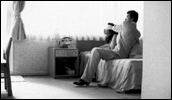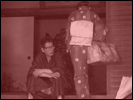I Am an SM Writer
- Year
- 2000
- Original title
- Futei no Kisetsu
- Japanese title
- 不貞の季節
- Director
- Cast
- Running time
- 88 minutes
- Published
- 20 March 2001



by Jasper Sharp
Anyone with more than a passing interest in Japanese film cannot have helped but notice the large extent to which sado-masochistic fantasies play a role in the industry's output in comparison with that of other nations. Ropes and breasts are a recurrent motif in films ranging from Tetsuji Takechi's Daydream and its remake (Hakujitsumu, 1964 and 1981), Teruo Ishii's Joys of Torture series (Tokugawa Onna Keibatsushi, 1968 et al) and, er, Rope and Breasts (Nawa to Chibusa, 1983 - Masaru Konuma). Not to mention the long tradition of ero-guro literature and manga comics.
Like so many of Japan's mainstream directors today (Lost Paradise's Yoshimitsu Morita and Shall We Dance's Masayuki Suo, to name but two), director Ryuichi Hiroki is no stranger to the pinku himself, having cut his teeth with Seigyaku! - Onna o Abaku (1982, a title which translates roughly as Sexual Ill-Treatment: Exposed Woman), maintaining an impressive output of sleaze up until recently with the experimentally steamy Midori in 1996. He has also taken time out to direct a couple of more mainstream hits, including Sadistic City (Maougai, 1993) and the athletic buddy movie, 800 Two Lap Runners, which was voted 7th best film of 1994 by the Kinema Junpo critics. His latest, Futei no Kisetsu, is an ironic look at the trials of an SM novelist, released under the tagline I Am an SM Writer over the same weekend as his DV-shot Tokyo Trash Baby, and two more diverse pieces of film-making I can not imagine.
Kitano regular and all-round familiar face Ren Osugi plays the eponymous narrator of the piece, a successful SM novelist who recounts the details of why his wife left him some 20 years before, due to his preoccupation with the more intellectual side of the sexual act as opposed to the physical. Immersed in his own fantasies, he feverishly documents staged sexual scenarios acted out in his living room by his editor (Murakami). Oblivious to the burgeoning sexuality of his own wife's (Hoshi), he fails to notice her increasing interest in her tennis partner, a brash young American hunk (Brian William Churchill - where the hell did they find this guy?) until the obvious is pointed out to him by the editor. His reaction, after the initial rage, is to scribble down the details of their imagined liaison. Eventually, bored with the lack of emotional depth to the relationship with the American, the wife moves on to the editor as a last-ditch attempt to provoke some degree of interest from her husband, a man who is more prone to ideas than the more carnal reality behind them.
I Am an SM Writer is scripted by Hitoshi Ishikawa, a former collaborator of Hiroki with whom he had hid behind the pseudonym Go Ijuin (alongside the third member of their production team, Genji Nakamura) for a series of pinku in the 1980s, which included Captured for Sex 2 (Kankin Sei no Dorei: Ikenie 2, 1986). It is an adaptation of a novel by Oniroku Dan, Japan's most celebrated S&M / fetish writer, and it is tempting to conjecture that it might be at least in some measure partly autobiographical. Dan's work formed the basis of a large number of Nikkatsu's steamy sexcapades in the early 70s, including a whole series marketed under his name starring Naomi Tani. He even had his own pinku production company, Oni Puro, for a brief period between 1969-'72 and directed his own film, Nikujigoku, in 1971. He took a brief break from porn writing in 1989 when he brought up the chess (!) magazine Shogi Journal, though made a return to the field when the magazine folded, and recently published a glossy photo book featuring the hardcore starlet of Takechi's 1981 remake of Daydream, Kyoko Aizome.
In itself, despite some rather strong scenes (a fleeting full frontal from Hoshi, following the lapse in Eirin's rigorous censorship standards over the past few years), I Am an SM Writer hardly exists for the sake of exploitation in its own right, but rather as a light-hearted comic drama set against this backdrop; a post-modern pinku, if you will. The bondage scenes are sparse and not staged for the sake of titillation, and for the most part the film charts the emotional trajectories of the author and his wife. Within this context, there is some validity to the whimsical portrayal of what would be considered a strict no-go area in other countries (probably the best way to play such scenes, I would be so bold as to suggest), but perhaps the key point of the S&M power play, as is so often forgotten, is that both partners consent to acting out their violent fantasies - the 'victim' in these scenes in this film is a paid model who laughs as she helps tie up her own knots and addresses the writer as 'sensei' (teacher/master).